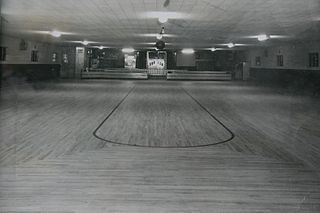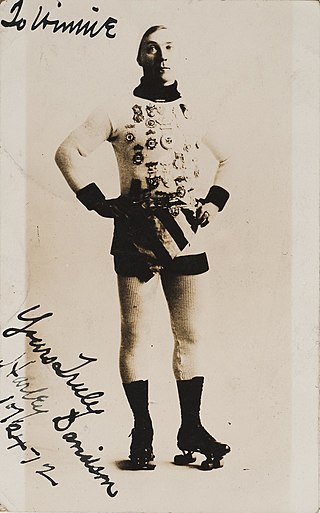James Leonard Plimpton (1828, Medfield, Massachusetts - 1911) was an American inventor who is known for changing the skating world with his patented roller skates in 1863. Plimpton's roller skates were safer and easier to use than the existing versions, his "rocker skates" or quad skates allowed people to steer by simply leaning to the left or the right. He also opened some of the earliest roller skating rinks in New York City and Newport, Rhode Island. In addition to opening the first, official, roller skating rink he also established the first roller skating club, that included rules of roller skating rink conduct, with how to roller skate lessons, and proficiency tests for skaters to plot their progress.
James Plimpton also invented the Plimpton cabinet bed. He married Harriet Amelia Adams on December 6, 1852.
Roller hockey is a form of hockey played on a dry surface using wheeled skates. It can be played with traditional roller skates or with inline skates and use either a ball or puck. Combined, roller hockey is played in nearly 60 countries worldwide.

Speed skating is a competitive form of ice skating in which the competitors race each other in travelling a certain distance on skates. Types of speed skating are long-track speed skating, short-track speed skating, and marathon speed skating. In the Olympic Games, long-track speed skating is usually referred to as just "speed skating", while short-track speed skating is known as "short track". The International Skating Union (ISU), the governing body of competitive ice sports, refers to long track as "speed skating" and short track as "short track skating". Long track speed skating takes place on a 400m ice track, while short track takes place on a 111m track.

Inline skates are boots with wheels arranged in a single line from front to back, allowing a skater to roll along on these wheels. Inline skates are technically a type of roller skate, but most people associate the term roller skates with quad skates, another type of roller skates with a two-by-two wheel arrangement similar to a car. Quad skates were popularized in the late 19th and early 20th centuries, while inline skates became prominent in the late 1980s with the rise of Rollerblade, Inc., and peaked in the late 1990s. The registered trademark Rollerblade has since become a generic trademark due to its popularity. To this day, "rollerblades" continues to be used in everyday language to refer to inline skates.

Roller skating is the act of travelling on surfaces with roller skates. It is a recreational activity, a sport, and a form of transportation. Roller rinks and skate parks are built for roller skating, though it also takes place on streets, sidewalks, and bike paths.

Inline skating is a multi-disciplinary sport and can refer to a number of activities practiced using inline skates. Inline skates typically have two to five polyurethane wheels depending on the style of practice, arranged in a single line by a metal or plastic frame on the underside of a boot. The in-line design allows for greater speed and maneuverability than traditional roller skates. Following this basic design principle, inline skates can be modified to varying degrees to accommodate niche disciplines.
USA Roller Sports (USARS), formerly the United States Amateur Confederation of Roller Skating, is the national governing body of competitive roller sports in the United States. It is recognized by the International Roller Sports Federation (FIRS) and the United States Olympic Committee.

Roller skates are shoes or bindings that fit onto shoes that are worn to enable the wearer to roll along on wheels. The first roller skate was an inline skate design, effectively an ice skate with wheels replacing the blade. Later the "quad skate" style became more popular, consisting of four wheels arranged in the same configuration as a typical car.

Inline hockey or roller hockey is a variant of hockey played on a hard, smooth surface, with players using inline skates to move and ice hockey sticks to shoot a hard, plastic puck into their opponent's goal to score points. The sport is a very fast-paced and free-flowing game and is considered a contact sport, but body checking is prohibited. There are five players including the goalkeeper from each team on the rink at a time, while teams normally consist of 16 players. There are professional leagues, one of which is the National Roller Hockey League (NRHL). While it is not a contact sport, there are exceptions, i.e. the NRHL involves fighting.

The Rink, a silent film from 1916, was Charlie Chaplin's eighth film for Mutual Films. The film co-starred Edna Purviance, Eric Campbell, Henry Bergman, and Albert Austin, and is best known for showcasing Chaplin's roller skating skills. Chaplin's obvious skill on roller skates surprised many of his fans, but Charlie was an experienced performer. As a touring vaudevillian with Fred Karno's pantomime troupe, Chaplin appeared in a roller-skating skit in which he displayed a talent for comedic falls—and the ability to cause other skaters to topple.

Roll Bounce is a 2005 American comedy-drama film written by Norman Vance Jr. and directed by Malcolm D. Lee. The film stars hip hop artist Bow Wow as the leader of a roller skating crew in 1970s Chicago. The film also includes Nick Cannon, Meagan Good, Brandon T. Jackson, Wesley Jonathan, Chi McBride, Kellita Smith, Jurnee Smollett and Mike Epps. The name of the film is derived from the 1979 song "Bounce, Rock, Skate, Roll" by Vaughan Mason & Crew.
The Women's Roller Hockey World Cup is a competition between the best female national teams in the World. It takes place every two years and it was organized by the FIRS until its integration into World Skate.

Roller hockey, rink hockey or hardball roller hockey is a team sport played on roller skates. It is a quad-skate team sport where two teams face-off against one another, trying to drive a hard ball with their sticks into the opposing teams' goalnet. Each team has five players on the rink at a time, four of whom are skaters and one who is the goalkeeper. The ball can only be put in motion by a stick, not the skate, otherwise a foul will be stated. The game has two 25-minute halves, with 15-minute halftime intermission, plus up to two 5-minute golden goal periods to settle ties with the clock stopping when the ball becomes dead. If the tie persists, a penalty shootout will determine the winner. Players – including the goalie – use quad skates, whereas inline skates are used in inline hockey. The sticks are similar to those in bandy and shinty. Excessive contact between players is forbidden in rink hockey, unlike inline hockey.

Don't Shove is a 1919 American short comedy film featuring Harold Lloyd. Prints of the film exist at the Library of Congress, the UCLA Film and Television Archive, the Museum of Modern Art, and the Cinémathèque québécoise.

A roller rink is a hard surface usually consisting of hardwood or concrete, used for roller skating or inline skating. This includes roller hockey, speed skating, roller derby, and individual recreational skating. Roller rinks can be located in an indoor or outdoor facility. Most skating center facilities range anywhere from under 14,000 square feet (1,300 m2) to more than 21,000 square feet (2,000 m2).

The European Confederation of Roller Skating, currently branded as World Skate Europe, is a governing body of roller skating and inline skating in Europe. The World Skate Europe is a member of World Skate, formerly the International Roller Sports Federation (FIRS).
Micajah C. Henley (1856–1927) was an American industrialist and inventor. He was a well known manufacturer of roller skates and bicycles sometimes known as "the roller skate king" or "king of roller skates".
Richmond Ice Rink was an ice skating rink at Clevedon Road, Twickenham, formerly in Middlesex and now in the London Borough of Richmond upon Thames. When it opened, in 1928, it had the longest ice surface in any indoor rink in the world and it soon became the premier rink in London. The rink closed in 1992 and the building was demolished.

The Oaks Park Roller Skating Rink is a roller rink at Oaks Amusement Park, in Portland, Oregon's Sellwood neighborhood, in the United States.

Fred Murree, also known as Bright Star, was a Pawnee professional roller skater. He has been called "the fastest man on wheels" of the early roller skating era.

Harley Davidson (1881–1946) was an American athlete, famous as a roller speed skater. He was also an ice speed skater, cyclist, and competed in other exhibition sports in the early 20th Century. Skaters competing across multiple sports was common then.